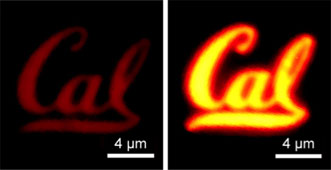BERKELEY, Calif., Nov. 26, 2015 — An organic superacid can smooth out defects in monolayer semiconductors, potentially making them more viable for applications such as transparent LED displays, ultrahigh-efficiency solar cells and photodetectors.
The chemical treatment method enhanced the quantum yield for molybdenum disulfide (MoS2) from <1 percent up to 100 percent, according to engineers at the University of California, Berkeley, and Lawrence Berkeley National Laboratory.
Monolayer semiconductors like MoS2 have promising electrical and luminescent properties, and their ability to withstand extreme mechanical deformation makes them suitable for flexible devices. But they are notoriously riddled with defects that hamper their performance.

The image on the left shows a MoS2 monolayer semiconductor before it was treated with superacid. On the right is the monolayer after treatment. The treatment enabled a two-orders-of-magnitude improvement in emitted light. Courtesy of Matin Amani.
"Traditionally, the thinner the material, the more sensitive it is to defects," said principal investigator Ali Javey, a professor of electrical engineering and computer sciences at Berkeley and a faculty scientist at Berkeley Lab. "This study presents the first demonstration of an optoelectronically perfect monolayer, which previously had been unheard of in a material this thin."
The researchers looked to superacids because they can lend protons, often in the form of hydrogen atoms, to other substances. This chemical reaction, called protonation, has the effect of filling in for the missing atoms at the site of defects, as well as removing unwanted contaminants stuck on the surface, the researchers said.
Processing with the superacid, called bistriflimide or TFSI, could also be useful in transistors manufacturing. As devices in computer chips get smaller and thinner, defects play a bigger role in limiting their performance.
"The defect-free monolayers developed here could solve this problem in addition to allowing for new types of low-energy switches," said Javey.
Funding for the research came from the U.S. Department of Energy, National Science Foundation, Center for Low Energy System Technology and Samsung. The findings were published in Science (doi: 10.1126/science.aad2114).